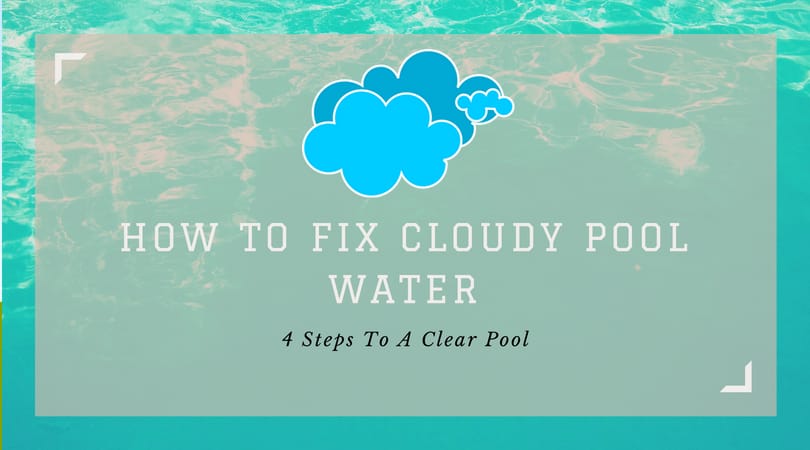Why Is My Pool Water Cloudy?
This new article, I go through everything you need to know about cloudy pool water.
First, I’ll show you the core reason/s why your pool water is cloudy.
Then…I’ll dive into some simple methods to bring back the cloudy water to a pristine clear level.

Typically There Are 3 Main Reasons Why Your Pool Water Is Cloudy.
Poor Filtration
The pump and filter are essentially the heart of the swimming pool filtration system. Water is pulled from the pool through the skimmer box, pushed through the filter, and returned to the pool through the main returns jets.
The entire water filtration of your swimming pool is dictated by the effective operation of the pump and filter.
The filtration system cannot, in general, operate without the main pump operating efficiently, and the pool water cannot be filtered without the correct filter.
Therefore it’s crucial to be aware of the operational state of your pump & filter and perform periodic maintenance to ensure the pump operates at an effective level and the filter is within the use by date.
Another factor of poor filtration is chemical demand. During the summer months, the chemical demand is at its peak, and therefore will require the filtration system be operated at longer cycles.
Improper Or Imbalanced Chemicals
As your pool water is always in a state of constant change, it is essential to periodically test the chemical balance and add the correct pool water chemicals where required.
Too much or too little chlorine can be the result of an improper chemical balance such as low or high pH levels.
Another factor to consider is high calcium hardness levels. If the calcium hardness becomes too hard, this can result in cloudy water and no matter how much effort you go to clearing up the water, it will just remain cloudy.
Inclement Weather And Foreign Debris
Leaves, dust and pollen can accumulate in your skimmer box or filter and begin to impede the filtration process.
Direct rainwater and/or run-off water after heavy rain activity can also contribute to cloudy pool water.
Rainwater will have high acidic properties that will have a negative effect on your pool water chemical balance.
When rainwater enters you pool, it can drastically change your water’s pH, fluctuate total dissolved solids (TDS), increase the calcium hardness, alkalinity and other chemical levels.
Is It Safe To Swim In A Pool If The Water Is Cloudy?
Instances where your pool water is cloudy, is an indication there is an imbalance of chemicals which has resulted in the water becoming unhygienic.
Bacteria and pathogens will be present in cloudy pool water. The most common bacteria present in cloudy pool water is E. coli which can cause stomach problems, eye irritation and worse yet, urinary tract infections.
Apart from the imminent health issues, cloudy water will make it difficult for swimmers to see the bottom and supervisors to keep an eye on novice swimmers increasing the risk of drowning.
4 Steps To Clear Your Cloudy Swimming Pool Water
Remove foreign particles, scrub down and vacuum up the pool
The environment and weather are typically the core reason for cloudy pool water. Rain water dilutes and raises pH levels therefore reducing free chlorine levels.
Body oil and sunscreen also accumulates in the pool which breaks down the free chlorine levels.
When your pool is not sanitising efficiently, algae begins to form.
Clean down the walls with a stiff brush, clean out the skimmer box and vacuum the pool to drain / waste.
Important – Don’t vacuum the pool through the re-circ system as the unwanted foreign particles and potential algae growth will just re-enter.
Clean Or Replace Filters
A poor water-filtration system can be a big problem. If your water cannot filtrate properly, it will not remove foreign particles.
As your pool is already in early phases of algae growth, you will need to thoroughly clean or (best) replace the filter/s.
Sand filters should be regularly backwashed to drain / waste and cartridge filters should be replaced every 200 hours or typically 12-18 months.
Make sure your pump and filter is the correct size for your pool. Also consider the duration of time your filtration system is running.
Most homes will need 6-10 hours of operation. This will all depend on the amount of use, the season (Summer will require longer duration) and size of your pool.
Chlorine Shock Treatment
To remove any potential bacteria, algae and other organic contaminants, shock your pool with a mega dose of chlorine.
Excellent for use after a heavy swimming use or heavy rain periods, it will quickly kill or neutralise all organic substances.
If your pool water is cloudy due to algae growth, you may have to repeat this process two or three times.
Balance Chemical Levels
After the initial chlorine shock treatment, your pool water should clear up.
When the cloudy water has dissipated, you will need to balance out the chemical levels.
Its critical to test your pool water by using a DIY method such as test strips or by taking a water sample to your nearest pool supplies shop.
Trojan Pool Services has two pool shop locations on the Gold Coast, where we offer free water testing, followed by a detailed breakdown of what chemicals to add and at what intervals.
Understanding pool chemistry is difficult and can be quite complex.
Adding the incorrect amounts or wrong chemicals are the major causes of cloudy water and may even lead to the return of algae growth.
Three Key Chemical Imbalance Levels To Test For.
High pH
The pH level is in-directly associated with turning your pool water cloudy. When you have frequent high levels of pH, it consumes and renders free chlorine ineffective.
Accuratley testing your pH levels and maintaining them between the recommeded scale is key to eliminate flucuations in chemical balance.
Safe pH Level For Swimming?
The correct level of pH in a swimming pool should be between 7.4 and 7.8, with 7.6 being the ideal level.
How To Balance Out The pH In Your Pool?
To lower pH, you need to use a pH reducer. The Dry Acid pH Decreaser is a user friendly alternative to liquid acid.
Available in a 3kg durable plastic containers for easy storage they are fast acting and effectively decreases the pH after periods of cloudy water.
Anything below a pH of 7.0 is too low, and apart from turning water cloudy, this environment will introduce harmful bacteria, such as algae.
When your pool water is too acidic, you will need to use a pH Increaser such as soda ash.
Chlorine
When the free chlorine level goes down, it forms combined chlorine (chloramine), which turns the pool water cloudy.
This is because the chlorine has become ineffective in killing bacteria and other organisms such as algae.
Optimium Chlorine Levels.
Total chlorine should be 3 ppm and Combined Chlorine should always be below 0.5 ppm (or 0 ppm if possible) to avoid chloramine.
Low free chlorine levels are caused by heavy usage, heavy rainfall (which dilutes the chlorine), or hot sunny days when UV light oxidises the free chlorine.
In summary, if your combined chlorine levels read above 0.5 ppm, your water may turn cloudy and become unsafe for swimming. If this is the case, you need to chlorine shock your pool immediately.
How To Know If The Chlorine Is Imbalanced?
You should test chlorine levels on a daily basis after cases of cloudy water and adjust it as appropriate before there’s excess chloramine, especially during the summer when it’s hot and the pool is used heavily.
The wider the range between free and total chlorine, the more combined chlorine (chloramine) is present in the water. Combined chlorine should always read below 0.5 ppm or just 0 ppm, if possible.
High Total Alkalinity
The Total Alkalinity of your pool water is often called the “buffer”. It helps the water resist drastic changes in pH.
Total alkalinity is a measure of your water’s ability to neutralize acids, so it’s an important part of balancing pH levelsHigh alkalinity typically causes stubbornly high pH levels that are very difficult to lower.
A high-pH environment can result in high calcium levels, making the water cloudy or causing “scale,” a hard, crusty mineral build-up.
Too-high levels of alkalinity can also result in green water (Algae). It can reduce the effects of the chlorine you use to keep algae under control.
How To Balance Total Alkalinity (TA)?
Finally, ensure that total alkalinity is within the required range of 80 ppm and 120 ppm to avoid bringing up pH levels and causing calcium scaling.
To increase Total Alkalinity levels, add pH Buffer (Sodium Bicarbonate)
To lower total alkalinity levels, add muriatic acid. This will restore pH levels without having to add a pH increaser.
Frustrated by continually testing, adding chemicals and trying to keep your pool clear all the time?
We cut out all the fluff and confusion of pool maintenance and provide Gold Coast residents with pool servicing and advice
Using our computerised water testing equipment, we’ll give you a fast, accurate diagnosis about the condition of your pool water and prescribe exactly what your pool needs to keep it in great condition.

